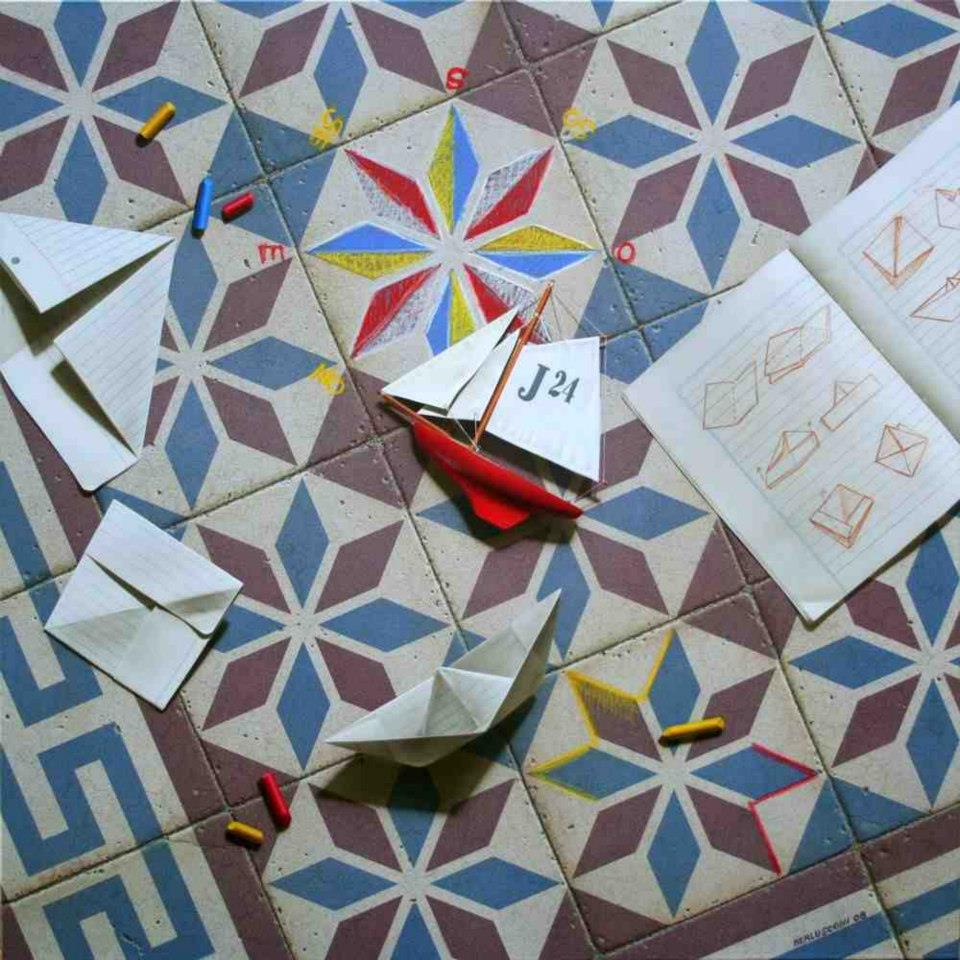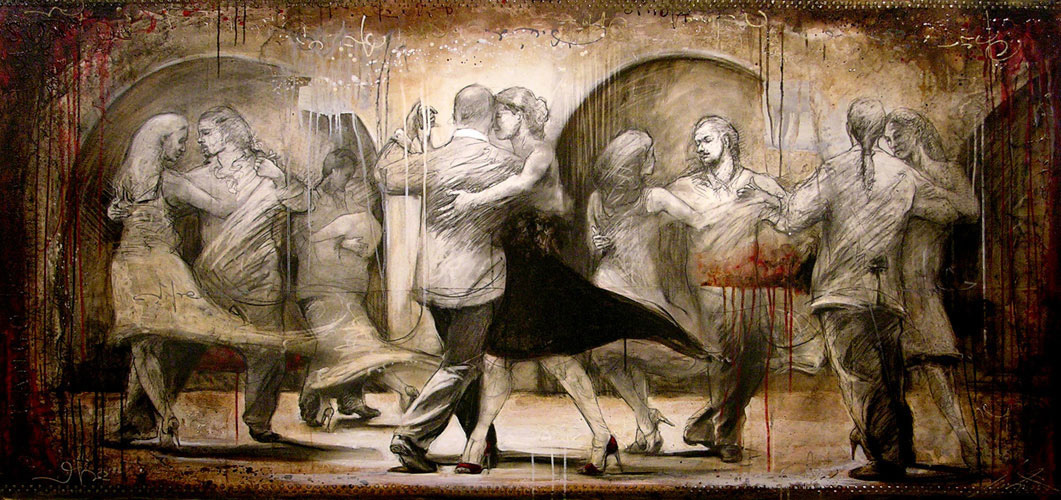PIEL DE AGUA
Nada hay en el mundo, y con ello en la existencia, que carezca de importancia para Javier Torices. Apunto esto desde el aviso que el observador recibe en los recodos y extensión de su hacer pictórico. Un hacer de artista que urde con firmeza y mesura al abrazo de un rigor que convierte la realidad en imagen, imposible atribuir a nadie más, fruto de la importancia y la perspicacia óptica que regala a lo observado.
Porque la suya es pintura de autor en permanente diálogo consigo mismo, actuando como mediador el impulso perenne de un pensamiento que trasciende al espectador desde sus asuntos. De ahí que podamos señalar que nada de cuanto el mundo es, resulta ajeno al juicio de la realidad individual a la que Javier Torices invita.
Desde la liturgia de la pintura, que tantas veces sus manos han iniciado para concluir y traer al arte escenarios vividos, es posible sentir el maridaje y la comprensión del autor acerca de la propia naturaleza –de la primera persona- y el modo en que la vida y el mundo se presentan.
Nada queda al azar en las miradas nacidas para ser pintura. Pintura y vida, porque las maneras en que Torices aborda la realidad, nos remiten al propio devenir de un artista pródigo en recursos y generoso en sus facultades; tanto, que el observador no puede evitar sentirse casi turbado ante esa extraña agudeza técnica con la propiedad de sobrecoger por cuanto dice, encandilando por su sobriedad y enjundia de peso creativo.
Como acabo de apuntar, Javier es artista de retos, no de alardes; sí de compromiso personal en cuyas conclusiones mucho tiene que ver su capacidad reflexiva, igual en la resolución de asuntos como en el hecho mismo de que sus contenidos se correspondan con el sentido emocional que pone alma a lo pintado.
Con toda seguridad, es por eso que en su obra los ecos de la ciudad tengan mucho que decir y se hallen relacionados con un plano de situación donde las luces y sombras, la noche y el día dibujan el contraste entre esa naturaleza propia, y una ordenación surgida de la medida humana que se pierde en las proporciones para ser cobijo, que Torices domina con mirada de pintor; también para ser paisaje y atmósfera inventada en arquitecturas sahumando el encuentro con las distancias y el horizonte de verdad hecha en los ambientes, la bruma o los destellos. Una arquitectura que Javier lleva dentro de sí y vertebra en sus cuadros sin trasgresión y, sin embargo, suya en los sonidos enmudecidos, solas entre la batahola del trasiego, lejanas acaso por tan cercanas e inspirada en la trazada pictórica tentando el lienzo, como quien busca y halla el pulso animado por donde la ciudad respira y el ruido se silencia en la mirada mascullando al sentir.
Torices pinta la noche. Investiga y crea esfumatos de autor. Pinta la noche acaudalada y el día sereno. Ahí, la obra de Javier se arma de visiones renovadas y encanto entre el esplendor y el pensar cautivo como quien mira al horizonte huido en lo propio con punto de fuga en la realidad. La ciudad en la noche y el día de Torices es una e infinita, para vestirse de nuevos recodos y arquitectura, tocada de ese ambiente propio que se suscita cuando se está en el sitio sabiendo, en fin, que es destreza de pintor e ilusión para los sentidos, propiciando remembranzas, emociones y el tono justo en el que el tiempo es uno, quieto, ese que toca somero la melancolía.
Y es al hilo de este reto que tiempo ha se impuso, desde donde Torices apunta un más allá en sus propuestas. El pintor sabe y es consciente que no es fácil la empresa que sobre sus espaladas se echa. Aún así, se arroja a ello convenciendo y sorprendiendo al observador.
Javier Torices, se adentra en la mar, en el agua, en sus formas y efectos, conformando un nuevo orden estilístico que nada tiene que ver con el asunto de marinas. El artista se moja, se empapa, estudia la superficie de las aguas y el paisaje que construye. Fija su atención en las maneras del ambiente haciendo cresterar el líquido que parece amasado en la labor de sus caricias y los golpes de su pasión, mientras la pintura modela las henchidas sensaciones de lo inconmensurable.
La mar de Torices es litoral de huella jugando entre la arena y la mar, es playa de fino lecho perdida y perfecta retratada y, sin embargo, dispersa al ocio y al recreo, para ser soledad animada y ritmo de poesía al estímulo de su vera. Agua y arena besada de espuma en olas, efímeras tocadas de pincel, razonadas con el mar de las ideas pensadas para el tacto de la mirada y burbujas imposibles pintar empero pintadas.
La mar de Torices es más que todo esto. Parece así haberla sabido y experimentado la densidad que la agita. El tono de su piel y color del abismo. Porque Javier sabe que la mar tiene piel y se relaja o aflige, se enhiesta o compunge como el cuerpo se eriza de frío o emoción, de interior azorado o profético, dejando que esos rotundos y poderosos primeros planos de oscuridad transparente nos adviertan el lugar desde donde el pintor mira.
Y mira desde los adentros, desde la hondura que somete al artista a hacer del mar, la mar no interferida de subjetivo significado, ni concesiones a la épica. Torices pinta la mar desde la superficie hasta lo profundo. De tan grande, casi perpendicular a la mirada, dejando asomar tierra, sin apelar a la sugerencia. Necesita pintar la mar como es y la vemos; insondable, casi negra, azul, verde o espejo punzante de luces y, en primer lugar de la escena, al fondo, vistas desde las afueras, acaso la ciudad, la reverencia al horizonte no resuelto en fusiones frías sino en arquitecturas trabajadas de poemas, elegidas en sus armonías desde esa mar desde la que mira y vadea.
Porque el artista se moja, se empapa y pintando desde la verdad como pinta, retrata la mar que inspira, la mar y su presencia, sin jarandacas, ni decorada; pinta la mar que es, honda, grande que por ser así, así la pinta, sentida como musa y épica de piel desnuda.
Juan Antonio Tinte
quote.jpg)
.jpg)


.jpg)
.jpg)
.jpg)
.jpg)
.jpg)
.jpg)
.jpg)
.jpg)
.jpg)
.jpg)
.jpg)
.jpg)
.jpg)
.jpg)
.jpg)
.jpg)
.jpg)
.jpg)
.jpg)
.jpg)
.jpg)
.jpg)
.jpg)
.jpg)
.jpg)
.jpg)
.jpg)
.jpg)
.jpg)
.jpg)
.jpg)
.jpg)
.jpg)
.jpg)
.jpg)


.jpg)
.jpg)
.jpg)
.jpg)
.jpg)


.jpg)
.jpg)
.jpg)
.jpg)
.jpg)
.jpg)
.jpg)
.jpg)
.jpg)
.jpg)

.jpg)
.jpg)
.jpg)
.jpg)
.jpg)
.jpg)
.jpg)
.jpg)
.jpg)
.jpg)
.jpg)
.jpg)
.jpg)
.jpg)
.jpg)
.jpg)
.jpg)
.jpg)
.jpg)
.jpg)
.jpg)
.jpg)
.jpg)
.jpg)
.jpg)
.jpg)
.jpg)
.jpg)
.jpg)
.jpg)
.jpg)


.jpg)
.jpg)
.jpg)
.jpg)
.jpg)
.jpg)
.jpg)
.jpeg)
.jpg)
.jpeg)
.jpg)
.jpg)
.jpg)
.jpg)


























.jpg)
.jpg)
.jpg)
.jpg)
.jpg)
.jpg)
.jpg)
.jpg)
.jpg)
.jpg)
.jpg)
.jpg)
.jpg)
.jpg)
.jpg)
.jpg)
.jpg)
.jpg)
.jpg)
.jpg)
.jpg)
.jpg)
.jpg)
.jpg)
.jpg)
.jpg)
.jpg)
.jpg)
.jpg)
.jpg)
.jpg)
.jpg)
.jpg)
.jpg)
.jpg)
.jpg)
.jpg)
.jpg)
.jpg)
.jpg)
.jpg)
.jpg)
.jpg)
.jpg)
.jpg)
.jpg)
.jpg)
.jpg)
.jpg)
.jpg)
.jpg)
.jpg)
.jpg)
.jpg)
.jpg)
.jpg)
.jpg)
.jpg)
.jpg)
.jpg)
.jpg)
.jpg)
.jpg)
.jpg)
.jpg)
.jpg)
.jpg)
.jpg)
.jpg)
.jpg)
.jpg)
.jpg)
.jpg)
.jpg)
.jpg)
.jpg)
.jpg)
.jpg)
.jpg)
.jpg)
.jpg)
.jpg)
.jpg)
.jpg)
.jpg)
.jpg)






.jpg)
.jpg)
.jpg)
.jpg)
.jpg)
.jpg)
.jpg)
.jpg)
.jpg)
.jpg)
.jpg)
.jpg)
.jpg)
.jpg)











.jpg)
.jpg)
.jpg)
.jpg)
.jpg)
.jpg)
.jpg)
.jpg)
.jpg)
.jpg)
.jpg)
.jpg)
.jpg)
.jpg)
.jpg)
.jpg)
.jpg)
.jpg)
.jpg)
.jpg)
.jpg)
.jpg)
.jpg)

.jpg)
.jpg)
.jpg)
.jpg)
.jpg)
.jpg)
.jpg)
.jpg)
.jpg)
.jpg)
.jpg)
.jpg)
.jpg)
.jpg)
.jpg)
.jpg)
.jpg)
.jpg)
.jpg)
.jpg)
.jpg)
.jpg)
.jpg)
.jpg)
.jpg)
.jpg)
.jpg)
.jpg)
.jpg)
.jpg)
.jpg)
.jpg)
.jpg)
.jpg)
.jpg)
.jpg)
.jpg)
.jpg)
.jpg)
.jpg)
.jpg)
.jpg)
.jpg)
.jpg)
.jpg)
.jpg)
.jpg)
.jpg)
.jpg)
.jpg)
.jpg)
.jpg)
.jpg)
.jpg)
.jpg)
.jpg)
.jpg)
.jpg)
.jpg)
.jpg)